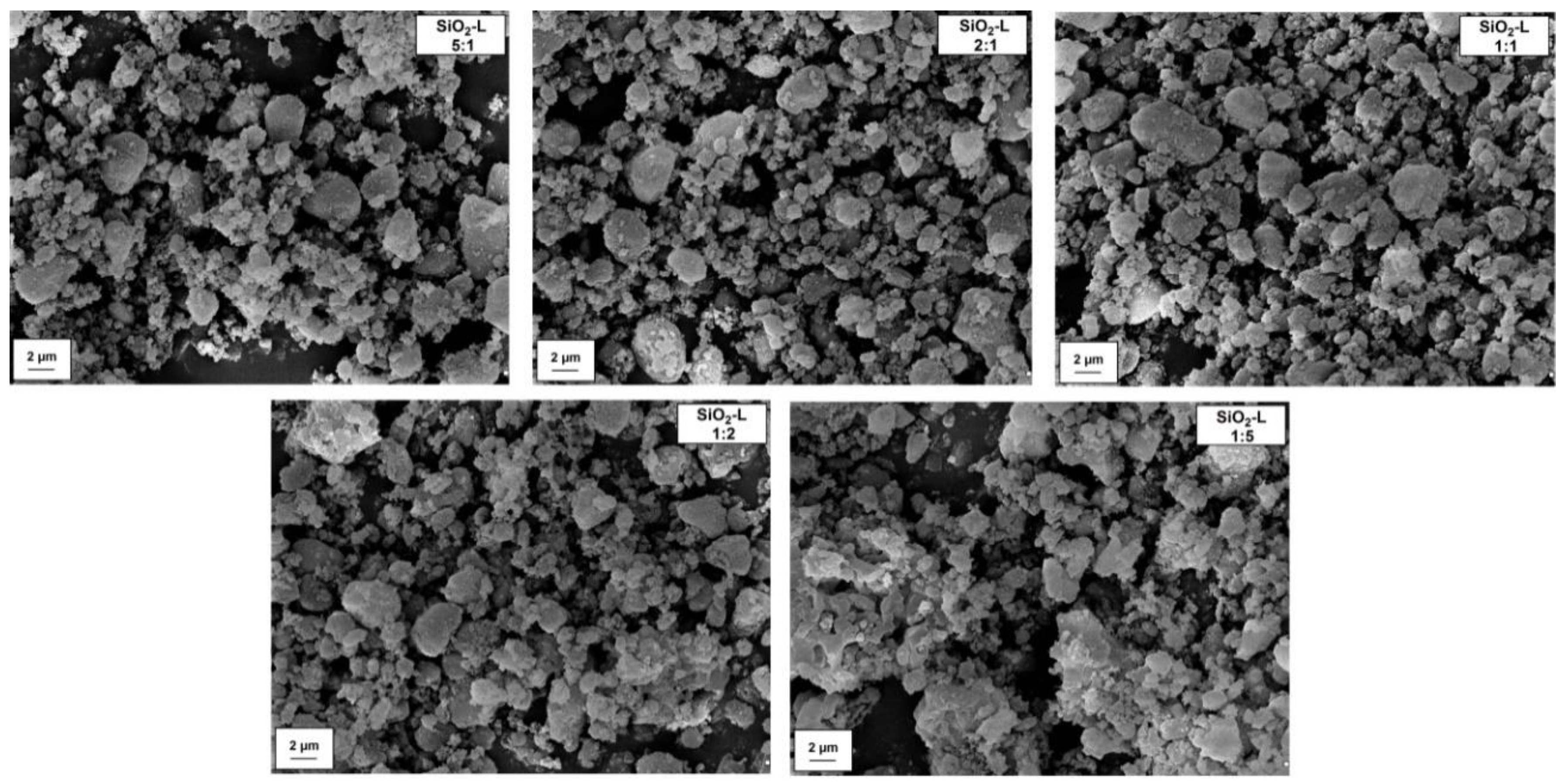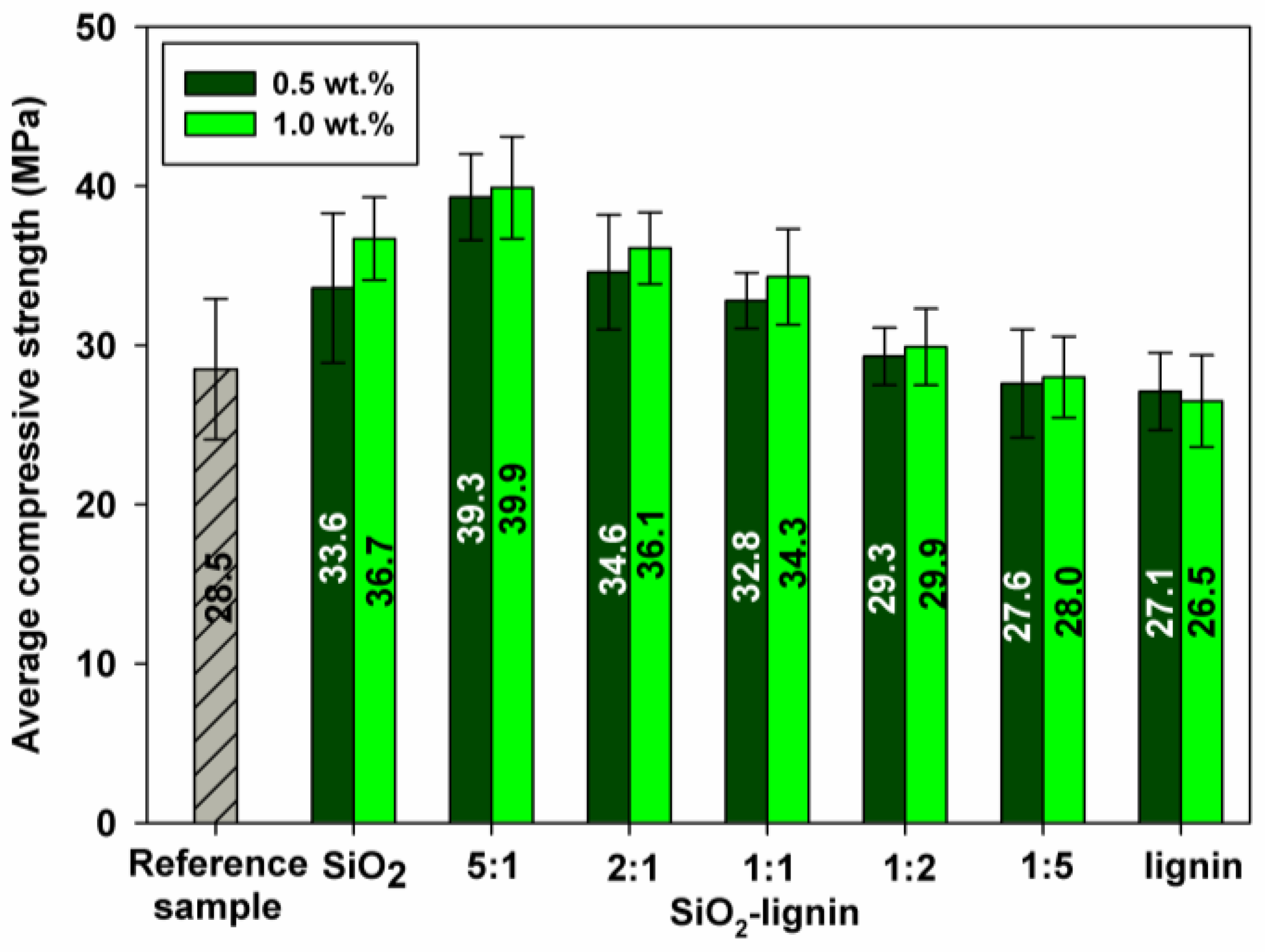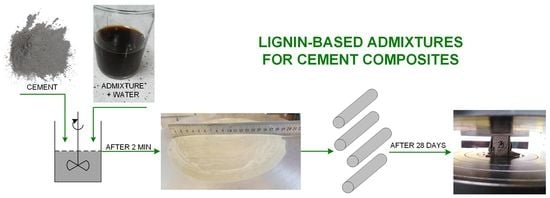Biopolymer-Based Hybrids as Effective Admixtures for Cement Composites
Abstract
:1. Introduction
2. Materials and Methods
2.1. Materials
2.2. Preparation of Silica-Lignin Hybrids
2.3. Physicochemical and Dispersive-Microstructural Characteristics of Inorganic-Organic Hybrids
2.4. Preparation of Cement Pastes
2.5. Cement Pastes Tests
2.5.1. Mixture Consistency
2.5.2. Compressive Strength Test
2.5.3. Microstructural Analysis
3. Results and Discussion
3.1. Physicochemical and Dispersive-Microstructural Characteristics of Inorganic-Organic Hybrids
3.1.1. Dispersive-Microstructural Properties
3.1.2. Fourier Transform Infrared Spectroscopy
3.1.3. Colorimetric Analysis
3.2. Cement Pastes Properties
3.2.1. Slump Test Results
3.2.2. Compressive Strength Properties with the Silica, Lignin and Silica-Lignin Hybrid Materials
3.2.3. SEM Analysis of Cement Composite with the Silica, Lignin and Silica-Lignin Hybrid Materials
4. Conclusions
Author Contributions
Funding
Conflicts of Interest
References
- Macdonald, A.J. Structure and Architecture, 3rd ed.; Routledge Taylor & Francis Group: London, UK, 2018. [Google Scholar]
- Plank, J. Applications of Biopolymers in Construction Engineering. In Biopolymers: Biology, Chemistry, Biotechnology, Applications, Volume 10, General Aspects and Special Applications; Steinbuchel, A., Ed.; Wiley VCH: Weinheim, Germany, 2003; pp. 29–39. [Google Scholar]
- Gopalakrishnan, K.; Ceylan, H.; Kim, S. Renewable biomass-derived lignin in transportation infrastructure strengthening applications. Int. J. Sustain. Eng. 2013, 6, 316–325. [Google Scholar] [CrossRef] [Green Version]
- Hottle, T.A.; Bilec, M.M.; Landis, A.E. Sustainability assessments of bio-based polymers. Polym. Degrad. Stabil. 2013, 98, 1898–1907. [Google Scholar] [CrossRef]
- Pacheco Torgal, F.; Mistretta, M.; Kaklauskas, A.; Granqvist, C.G.; Cabeza, L.F. Nearly Zero Energy Building Refurbishment, 1st ed.; Springer: London, UK, 2013. [Google Scholar]
- Seto, K.C.; Güneralp, B.; Hutyra, L.R. Global forecasts of urban expansion to 2030 and direct impacts on biodiversity and carbon pools. Proc. Natl. Acad. Sci. USA 2012, 109, 16083–16088. [Google Scholar] [CrossRef] [PubMed] [Green Version]
- Jawaid, M.; Abdul Khalil, H.P.S. Cellulosic/synthetic fibre reinforced polymer hybrid composites: A review. Carbohydr. Polym. 2011, 86, 1–18. [Google Scholar] [CrossRef]
- Thakur, V.K.; Thakur, M.K.; Gupta, R.K. Review: Raw natural fiber–based polymer composites. Int. J. Polym. Anal. Character. 2014, 19, 256–271. [Google Scholar] [CrossRef]
- Thakur, V.K. Green Composites from Natural Resources, 1st ed.; CRC Press: Boca Raton, FL, USA, 2013. [Google Scholar]
- Wysokowski, M.; Petrenko, I.; Stelling, A.L.; Stawski, D.; Jesionowski, T.; Ehrlich, H. Poriferan chitin as a versatile template for Extreme Biomimetics. Polymers 2015, 7, 235–265. [Google Scholar] [CrossRef] [Green Version]
- Isikgor, F.H.; Becer, C.R. Lignocellulosic biomass: A sustainable platform for the production of bio-based chemicals and polymers. Polym. Chem. 2015, 6, 4497–4559. [Google Scholar] [CrossRef] [Green Version]
- Babu, R.P.; O’Connor, K.; Seeram, R. Current progress on bio-based polymers and their future trends. Prog. Biomater. 2013, 1, 2–16. [Google Scholar] [CrossRef] [Green Version]
- Plank, J. Applications of biopolymers and other biotechnological products in building materials. Appl. Microbiol. Biotechnol. 2004, 66, 1–9. [Google Scholar] [CrossRef]
- Pacheco-Torgal, F.; Ivanov, V.; Karak, N.; Jonkers, H. Biopolymers and Biotech Admixtures for Eco-Efficient Construction Materials, 1st ed.; Woodhead Publishing Books—Elsevier: Cambridge, UK, 2016. [Google Scholar]
- Huang, J.; Fu, S.; Gan, L. Lignin Chemistry and Applications, 1st ed.; Elsevier: Amsterdam, The Netherlands, 2019. [Google Scholar]
- Patural, L.; Marchal, P.; Govin, A.; Grosseau, P.; Ruot, B.; Devès, O. Cellulose ethers influence on water retention and consistency in cement-based mortars. Cement Concrete Res. 2011, 41, 46–55. [Google Scholar] [CrossRef] [Green Version]
- Green, K.M.; Carter, M.A.; Hoff, W.D.; Wilson, M.A. The effects of lime and admixtures on the water-retaining properties of cement mortars. Cement Concrete Res. 1999, 29, 1743–1747. [Google Scholar] [CrossRef]
- Khayat, K.H. Viscosity enhancing admixtures for cement-based materials—An overview. Cement Concrete Compos. 1998, 20, 171–188. [Google Scholar] [CrossRef]
- Klapiszewski, Ł.; Jesionowski, T. Novel lignin-based materials as products for various applications. In Handbook of Composites from Renewable Materials, Volume 6, Polymeric Composites; Thakur, V.K., Thakur, M.K., Kessler, M.R., Eds.; Wiley Scrivener Publishing: Hoboken, NJ, USA, 2017; pp. 519–554. [Google Scholar]
- Sipponen, M.H.; Lange, H.; Crestini, C.; Henn, A.; Österberg, M. Lignin for nano- and microscaled carrier systems: Applications, trends, and challenges. ChemSusChem 2019, 12, 2039–2054. [Google Scholar] [CrossRef] [PubMed]
- Zdarta, J.; Meyer, A.S.; Jesionowski, T.; Pinelo, M. Multi-faceted strategy based on enzyme immobilization with reactant adsorption and membrane technology for biocatalytic removal of pollutants: A critical review. Biotechnol. Adv. 2019, 37, 107401. [Google Scholar] [CrossRef] [PubMed]
- Jędrzak, A.; Rębiś, T.; Klapiszewski, Ł.; Zdarta, J.; Milczarek, G.; Jesionowski, T. Carbon paste electrode based on functional GOx/silica-lignin system to prepare an amperometric glucose biosensor. Sens. Actuator B Chem. 2018, 256, 176–185. [Google Scholar] [CrossRef]
- Jędrzak, A.; Rębiś, T.; Nowicki, M.; Synoradzki, K.; Mrówczyński, R.; Jesionowski, T. Polydopamine grafted on an advanced Fe3O4/lignin hybrid material and its evaluation in biosensing. Appl. Surf. Sci. 2018, 455, 455–464. [Google Scholar] [CrossRef]
- Appa Rao, G. Investigations on the performance of silica fume-incorporated cement pastes and mortars. Cement Concrete Res. 2003, 33, 1765–1770. [Google Scholar]
- Zapata, L.E.; Portela, G.; Suárez, O.M.; Carrasquillo, O. Rheological performance and compressive strength of superplasticized cementitious mixtures with micro/nano-SiO2 additions. Constr. Buil. Mater. 2013, 41, 708–716. [Google Scholar] [CrossRef]
- Singh, L.P.; Karade, S.R.; Bhattacharyya, S.K.; Yousuf, M.M.; Ahalawat, S. Beneficial role of nanosilica in cement based materials—A review. Constr. Build. Mater. 2013, 47, 1069–1077. [Google Scholar] [CrossRef]
- Kong, D.; Su, Y.; Du, X.; Yang, Y.; Wei, S.; Shah, S.P. Influence of nano-silica agglomeration on fresh properties of cement pastes. Constr. Build. Mater. 2013, 43, 557–562. [Google Scholar] [CrossRef]
- Ślosarczyk, A.; Kwiecińska, A.; Pełszyk, E. Influence of selected metal oxides in micro and nanoscale on the mechanical and physical properties of the cement mortars. Procedia Eng. 2017, 172, 1031–1038. [Google Scholar] [CrossRef]
- Bula, K.; Kubicki, G.; Jesionowski, T.; Klapiszewski, Ł. MgO–lignin dual phase filler as an effective modifier of polyethylene film properties. Materials 2020, 13, 809. [Google Scholar] [CrossRef] [PubMed] [Green Version]
- Klapiszewski, Ł.; Bula, K.; Dobrowolska, A.; Czaczyk, K.; Jesionowski, T. A high-density polyethylene container based on ZnO/lignin dual fillers with potential antimicrobial activity. Polym. Test. 2019, 73, 51–59. [Google Scholar] [CrossRef]
- Klapiszewski, Ł.; Tomaszewska, J.; Skórczewska, K.; Jesionowski, T. Preparation and characterization of eco-friendly Mg(OH)2/lignin hybrid material and its use as a functional filler for poly(vinyl chloride). Polymers 2017, 9, 258. [Google Scholar] [CrossRef] [PubMed]
- Klapiszewski, Ł.; Jamrozik, A.; Strzemiecka, B.; Koltsov, I.; Borek, B.; Matykiewicz, D.; Voelkel, A.; Jesionowski, T. Characteristics of multifunctional, eco-friendly lignin-Al2O3 hybrid fillers and their influence on the properties of composites for the abrasive tools. Molecules 2017, 22, 1920. [Google Scholar] [CrossRef] [PubMed] [Green Version]
- Bula, K.; Klapiszewski, Ł.; Jesionowski, T. A novel functional silica/lignin hybrid material as a potential bio-based polypropylene filler. Polym. Compos. 2015, 36, 913–922. [Google Scholar] [CrossRef]
- Klapiszewski, Ł.; Bula, K.; Sobczak, M.; Jesionowski, T. Influence of processing conditions on the thermal stability and mechanical properties of PP/silica-lignin composites. Int. J. Polym. Sci. 2016, 1627258, 1627258. [Google Scholar] [CrossRef] [Green Version]
- Borysiak, S.; Klapiszewski, Ł.; Bula, K.; Jesionowski, T. Nucleation ability of advanced functional silica/lignin hybrid fillers in polypropylene composites. J. Therm. Anal. Calorim. 2016, 126, 251–262. [Google Scholar] [CrossRef] [Green Version]
- Klapiszewski, Ł.; Nowacka, M.; Milczarek, G.; Jesionowski, T. Physicochemical and electrokinetic properties of silica/lignin biocomposites. Carbohydr. Polym. 2013, 94, 345–355. [Google Scholar] [CrossRef]
- Catauro, M.; Barrino, F.; Dal Poggetto, G.; Crescente, G.; Piccolella, S.; Pacifico, S. New SiO2/caffeic acid hybrid materials: Synthesis, spectroscopic characterization, and bioactivity. Materials 2020, 13, 394. [Google Scholar] [CrossRef] [Green Version]
- Catauro, M.; Tranquillo, E.; Risoluti, R.; Ciprioti, S.V. Sol-Gel synthesis, spectroscopic and thermal behavior study of SiO2/PEG composites containing different amount of chlorogenic acid. Polymers 2018, 10, 682. [Google Scholar] [CrossRef] [PubMed] [Green Version]
- Wysokowski, M.; Klapiszewski, Ł.; Moszyński, D.; Bartczak, P.; Szatkowski, T.; Majchrzak, I.; Siwińska-Stefańska, K.; Bazhenov, V.V.; Jesionowski, T. Modification of chitin with kraft lignin and development of new biosorbents for removal of cadmium(II) and nickel(II) ions. Marine Drugs 2014, 12, 2245–2268. [Google Scholar] [CrossRef] [PubMed] [Green Version]
- Kalliola, A.; Vehmas, T.; Liitia, T.; Tamminen, T. Alkali-O2 oxidized lignin—A bio-based concrete plasticizer. Ind. Crops Prod. 2015, 74, 150–157. [Google Scholar] [CrossRef]
- Li, S.; Li, Z.; Zhang, Y.; Liu, C.; Yu, G.; Li, B.; Mu, X.; Peng, H. Preparation of concrete water reducer via fractionation and modification of lignin extracted from pine wood by formic acid. ACS Sustain. Chem. Eng. 2017, 5, 4214–4222. [Google Scholar] [CrossRef]
- Arel, H.S. The effect of lignosulfonates on concretes produced with cements of variable fineness and calcium aluminate content. Constr. Build. Mater. 2017, 131, 347–360. [Google Scholar] [CrossRef]
- Klapiszewski, Ł.; Klapiszewska, I.; Ślosarczyk, A.; Jesionowski, T. Lignin-based hybrid admixtures and their role in cement composite fabrication. Molecules 2019, 24, 3544. [Google Scholar] [CrossRef] [Green Version]
- Roussel, N. Understanding the Rheology of Concrete, 1st ed.; Woodhead Publishing Books—Elsevier: Cambridge, UK, 2012. [Google Scholar]
- Diamond, H. The microstructure of cement paste and concrete—A visual primer. Cement Concrete Compos. 2004, 26, 919–933. [Google Scholar] [CrossRef]
- Scrivener, K.L. Backscattered electron imaging of cementitious microstructures: Understanding and quantification. Cement Concrete Compos. 2004, 26, 935–945. [Google Scholar] [CrossRef]










| Sample | Particle Diameter from Mastersizer 2000 (μm) | |||
|---|---|---|---|---|
| d(0.1) * | d(0.5) ** | d(0.9) *** | D[4.3] **** | |
| Silica Syloid 244 | 0.9 | 1.5 | 2.6 | 1.9 |
| SiO2-lignin (5:1 wt./wt.) | 1.2 | 1.9 | 2.9 | 2.3 |
| SiO2-lignin (2:1 wt./wt.) | 1.2 | 2.1 | 3.2 | 2.5 |
| SiO2-lignin (1:1 wt./wt.) | 1.5 | 2.9 | 3.9 | 3.3 |
| SiO2-lignin (1:2 wt./wt.) | 1.8 | 3.6 | 4.6 | 4.1 |
| SiO2-lignin (1:5 wt./wt.) | 1.9 | 4.1 | 5.4 | 4.8 |
| Kraft lignin | 2.0 | 5.2 | 8.4 | 6.5 |
| Sample | Vibrational Assignment | ||||||||
|---|---|---|---|---|---|---|---|---|---|
| ν O–H | ν C–Hx | ν C=O | ν C–C C=C | ν C–O(H) C–O(Ar) | ν Si–O | ν C–O–C | ν Si–OH | δ Si–O | |
| Wavenumber (cm−1) | |||||||||
| Silica Syloid 244 | 3450 | - | - | - | - | 1200 (s) 1102 (as) | - | 992 (as) 865 (s) | 512 |
| SiO2-lignin (5:1 wt./wt.) | 3447 | 2875 | 1660 | 1589 1515 1474 1442 | 1235 1196 | 1204 (s) 1105 (as) | 1083 1002 | 995 (as) 867 (s) | 515 |
| SiO2-lignin (2:1 wt./wt.) | 3441 | 2880 | 1659 | 1592 1518 1478 1443 | 1239 1198 | 1205 (s) 1105 (as) | 1084 1005 | 996 (as) 868 (s) | 516 |
| SiO2-lignin (1:1 wt./wt.) | 3434 | 2885 | 1664 | 1598 1521 1482 1448 | 1242 1203 | 1208 (s) 1107 (as) | 1087 1008 | 993 (as) 867 (s) | 520 |
| SiO2-lignin (1:2 wt./wt.) | 3432 | 2886 | 1667 | 1602 1525 1483 1449 | 1243 1203 | 1209 (s) 1109 (as) | 1090 1010 | 998 (as) 871 (s) | 519 |
| SiO2-lignin (1:5 wt./wt.) | 3428 | 2888 | 1671 | 1598 1520 1481 1447 | 1247 1205 | 1209 (s) 1110 (as) | 1091 1012 | 1003 (as) 876 (s) | 523 |
| Kraft lignin | 3410 | 2890 | 1670 | 1596 1518 1480 1445 | 1250 1208 | - | 1094 1015 | - | - |
© 2020 by the authors. Licensee MDPI, Basel, Switzerland. This article is an open access article distributed under the terms and conditions of the Creative Commons Attribution (CC BY) license (http://creativecommons.org/licenses/by/4.0/).
Share and Cite
Ślosarczyk, A.; Klapiszewska, I.; Jędrzejczak, P.; Klapiszewski, Ł.; Jesionowski, T. Biopolymer-Based Hybrids as Effective Admixtures for Cement Composites. Polymers 2020, 12, 1180. https://doi.org/10.3390/polym12051180
Ślosarczyk A, Klapiszewska I, Jędrzejczak P, Klapiszewski Ł, Jesionowski T. Biopolymer-Based Hybrids as Effective Admixtures for Cement Composites. Polymers. 2020; 12(5):1180. https://doi.org/10.3390/polym12051180
Chicago/Turabian StyleŚlosarczyk, Agnieszka, Izabela Klapiszewska, Patryk Jędrzejczak, Łukasz Klapiszewski, and Teofil Jesionowski. 2020. "Biopolymer-Based Hybrids as Effective Admixtures for Cement Composites" Polymers 12, no. 5: 1180. https://doi.org/10.3390/polym12051180
APA StyleŚlosarczyk, A., Klapiszewska, I., Jędrzejczak, P., Klapiszewski, Ł., & Jesionowski, T. (2020). Biopolymer-Based Hybrids as Effective Admixtures for Cement Composites. Polymers, 12(5), 1180. https://doi.org/10.3390/polym12051180









